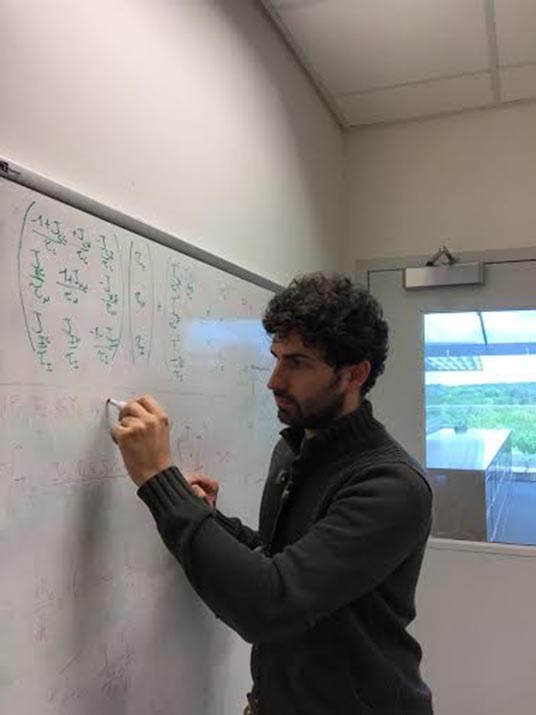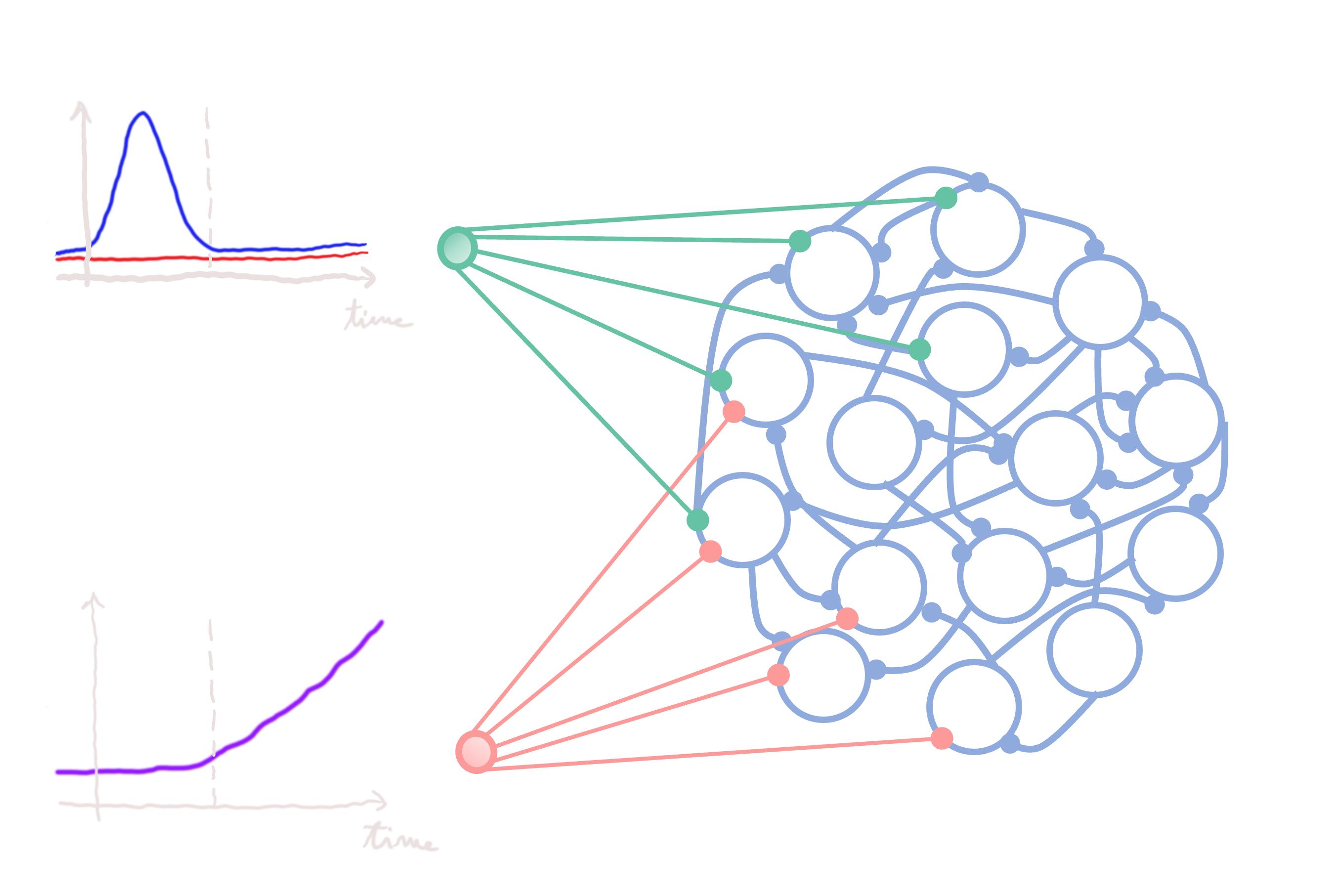Bio
I am a computational neuroscientist interested in how neural interactions give rise to cognitive phenomena,
how brain circuits change during learning, and how mental disorders disrupt
communication pathways in the brain. Currently I am a CENTURI Group Leader at Aix-Marseille University in France.
I enjoy reading literature and comic books, playing team sports, and strumming the guitar.
I love travelling, immersing myself in new cultures, and hiking in the mountains. I believe in economic and social equality, and that
there are no simple answers to the complex questions of this world.
Early education and graduate studies:
I was born in Milan, Italy, in 1984, and grew up in Rome. During my high school years at Liceo Classico E.Q. Visconti
I was introduced to ancient literature, history of philosophy and the great questions of life.
Being fascinated with the fundamental principles of Nature, I decided to learn about them and ended up earning a Bachelor's and a Master’s degree in physics
at La Sapienza University of Rome.
I particularly enjoyed classes in dynamical systems, condensed matter physics, statistical mechanics, and biophysics.
I became interested in neuroscience and machine learning thanks to
the lectures in artificial neural networks by Prof. Daniel Amit, where I discovered for
the first time that brain circuits can be analyzed and explained with the quantitative
methods of physics and mathematics. I then won a scholarship to study abroad and
worked for a year in the lab of Prof. Stefano Fusi at the Center for Theoretical Neuroscience of Columbia University.
The research I carried out in New York, with the co-supervision of Prof. Enzo Marinari, led to my Master’s thesis work
on the efficient storage capacity of Hopfield models with correlated patterns.
I did my PhD under the supervision of Prof. Anne-Lise Giraud at University of Geneva
and Prof. Boris Gutkin at the École Normale Supérieure in Paris.
In my PhD thesis investigated the neural basis
of speech processing, both with computational models and by analyzing neurophysiological data
from human patients.
During my postdoc, I have been studying the neurobiological mechanisms and
the computational principles of decision-making
during motor planning.
I built computational models of brain circuits and, in collaboration with the laboratory
of Dr. Karel Svoboda, tested the predictions from these models with optogenetic experiments in rodents.
Please check the Research section for more details.
Spoken languages:
Italian, English, French, Spanish.
Research
My general interest lies in understanding the neural basis and the evolution of intelligent behavior in animals and humans,
hoping that a better understanding of ourselves will lead to a more compassionate and just society.
Currently, my work is focused on building computational models of brain circuits in order to understand
the neural basis of cognition. I use dynamical systems, statistical and neural network models
to investigate how populations of neurons generate behavior. In particular, I have been studying the computational principles
behind decision-making, short-term memory and motor preparation. I truly enjoy collaborating with experimental research groups
to develop a common conceptual framework able to explain cognitive phenomena.
During my postdoc at Janelia
I primarily worked on two projects:
Project 1. How the brain holds on to short-term memory
We designed model-driven optogenetic perturbations
in the rodent premotor cortex, which allowed us to discriminate between candidate mechanisms of persistent activity,
the elevated spiking rates observed in single neurons that bridge sensory inputs with subsequent actions.
We were the first to demonstrate that, during short-term memory tasks, cortical activity in rodents is attracted towards a particular
set of spike rate patterns, called discrete attractors, that predict the specific future action.
Project 2. Neural mechanisms underlying the temporal evolution of flexible information flow across the brain
Sensory information can give rise to different behaviors under distinct circumstances.
To account for this, the brain must dynamically adjust the flow of information between sensory and decision areas.
In the context of decision-making, we considered whether and how decisions can be vulnerable to
distracting sensory inputs before they are enacted.
Our results indicated that decisions are, at first, vulnerable to interferences,
but become more resistant close to the time when decisions must be enacted.
To identify the neural mechanisms behind this temporally-evolving gating of sensory information,
I trained recurrent artificial neural networks (RNNs)
to reproduce the activity of neurons recorded from
the premotor cortex during a binary decision-making task in which decisions were challenged by distracting sensory information.
By reverse-engineering the networks, I discovered that decision-related activity patterns
in the RNN converged to a pair of stable spike rate patterns – i.e. two stable
fixed-points or discrete attractors, one for each decision.
Predictions from the RNN model were verified in the experimental data,
indicating that attractor dynamics govern how information flows from the sensory to the motor cortex.
Furthermore, to correctly reproduce the data, the recurrent network required
the presence of an external input signalling the passage of time within the trial.
These findings led me to challenge a long-standing hypothesis
on the role of slow neural timescales observed during decision-making tasks.
As we verified experimentally, these slow dynamics reflect
the predicted duration of a trial instead of indicating the formation of a decision.
Our results provide outlines of a general mechanism underlying flexible routing of information across the brain.
See also:
- Arseny Finkelstein*, Lorenzo Fontolan*,
Michael N Economo, Nuo Li, Sandro Romani, and Karel Svoboda; *equal contribution.
Attractor dynamics gate cortical information flow during
decision-making.
Nature Neuroscience, 24(6):843--850, 2021.
-
Closing the gate to distractors during decision-making. Chong, E., Akrami, A. Nat Neurosci 24, 763–764 (2021).
- Resisting distractions during decision-making
takes commitment from the prefrontal cortex, Janelia News
I presented my work at several conferences in the Neuroscience field (Sfn annual meetings, Cosyne, HHMI meetings).
For a complete list of posters and conference talks please see my CV.
Past and current collaborators:
Jan Ache, University of Wurzburg, Germany
Rosa Cossart, Inmed, France
Kayvon Daie, Allen Institute, USA
Arseny Finkelstein, University of Tel Aviv, Israel
Sabine Fischer, University of Wurzburg, Germany
Stefano Fusi, Columbia University of NY
Anne-Lise Giraud, University of Geneva, Switzerland
Boris Gutkin, ENS Paris, France
Alexandre Hyafil, Centre de Recerca Matemàtica, Barcelona, Spain
Hidehiko Inagaki, Max Planck Florida, USA
Maciej Krupa, INRIA Sophia Antipolis, France
Sandro Romani, Janelia Research Campus, USA
Karel Svoboda, Allen Institute, USA
Publications
|
[1]
|
Daie K, Fontolan L, Druckmann S, Svoboda K.
Feedforward amplification in recurrent networks underlies paradoxical neural coding.
bioRxiv 2023.08.04.552026, 2023.
|
|
[2]
|
Majumder S, Hirokawa K, Yang Z, Paletzki R, Gerfen CR, Fontolan L, Romani S, Jain A, Yasuda R, Inagaki H.
Cell-type-specific plasticity shapes neocortical dynamics for motor learning.
bioRxiv 2023.08.09.552699, 2023.
|
|
[3]
|
Inagaki HK, Chen S, Daie K, Finkelstein A, Fontolan L, Romani S, Svoboda K.
Neural algorithms and circuits for motor planning.
Annual Review of Neuroscience, Jul 8;45:249-271, 2022.
|
|
[4]
|
Finkelstein* A, Fontolan* L, Economo M, Li N, Romani S, Svoboda K; *equal contribution.
Attractor dynamics gate cortical information flow during
decision-making.
Nature Neuroscience, 24(6):843--850, 2021.
|
|
[5]
|
Inagaki HK, Fontolan L, Romani S, Svoboda K.
Discrete attractor dynamics underlies persistent activity in the
frontal cortex.
Nature, 566(7743):212--217, 2019.
|
|
[6]
|
Pefkou M, Arnal L, Fontolan L, Giraud AL.
θ-band and β-band neural activity reflects independent
syllable tracking and comprehension of time-compressed speech.
Journal of Neuroscience, 37(33):7930--7938, 2017.
|
|
[7]
|
Hyafil A, Giraud AL, Fontolan L, Gutkin B.
Neural cross-frequency coupling: connecting architectures,
mechanisms, and functions.
Trends in neurosciences, 38(11):725--740, 2015.
|
|
[8]
|
Hyafil A, Fontolan L, Kabdebon C, Gutkin B, Giraud AL.
Speech encoding by coupled cortical theta and gamma oscillations.
Elife, 4:e06213, 2015.
|
|
[9]
|
Fontolan L, Morillon B, Liegeois-Chauvel C, Giraud AL.
The contribution of frequency-specific activity to hierarchical
information processing in the human auditory cortex.
Nature communications, 5(1):1--10, 2014.
|
|
[10]
|
Fontolan L, Krupa MP, Hyafil A, Gutkin B.
Analytical insights on theta-gamma coupled neural oscillators.
The Journal of Mathematical Neuroscience, 3(1):1--20, 2013.
|
Contact
Email:
Email
lorenzo.fontolan[at]inserm.fr
Address:
Inmed
163 Avenue de Luminy
13005 Marseille, France

